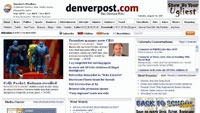Newspapers continue to challenge local TV Web sites

Television news is meeting stiff competition online. While the nation’s newspapers are in severe economic trouble, many are still aggressively expanding their video presence on their Web sites —challenging broadcasters who are also facing hard economic times. And they’re beating stations at their own game, doing a better job of hosting video clips that consumers want to watch.
Brightcove, a company that provides the video streaming platform to more than 30 major newspaper publishers across North America, Europe and Asia, reported last week an increased use of (and traffic for) video by newspapers on the Internet. Surveying 187 U.S. newspaper Web sites, Brightcove said uploads to the sites grew from an average of 186 per month to 638 in 2008, an increase of 1500 percent.
Brightcove’s clients include the “New York Times,” “Washington Post,” Hearst, and Cox Newspapers. It said all of its newspaper partners are monetizing video content with advertising. The main ad format, the company said, is the 30-second pre-roll video with 300 x 250 companion banner.
Even with the cutbacks and retrenchment in the newspaper industry, eMarketer is still predicting upwards of 5 percent growth in digital media advertising this year. This number is closer to 45 percent for online video advertising.
Most newspapers recognize the opportunity and continue to invest in video. Some newsrooms are training staffers in videography, hiring ex-television producers to boost the production value of their video products and delivering HD-quality content through their Web sites.
Others are sending staffers for independent training to places like the Platypus Workshops, which are held throughout the country. Sponsored by the Digital Journalist Web site run by famed news photographer Dirck Halstead, the intense training sessions last about 10 days and cost about $2000 for each journalist.
The growth of newspaper video is being driven by several factors, including:
The professional video industry's #1 source for news, trends and product and tech information. Sign up below.
- lower video production costs;
- higher-quality online video delivery;
- the availability of on-demand platforms like Brightcove vs. building in-house solutions;
- the influx of advertising dollars to the Web; and
- the ongoing migration of consumers from traditional print and broadcast to online media outlets.
In a threat to traditional television newscasts, newspapers are producing more video in conjunction with their print reporting, and consumers now expect to see a mix of media (text, images, audio, video) woven together in the context of almost every Web site experience. As a result, videos are increasingly embedded in a wider range of editorial features on newspaper Web sites.
